Self-Reflection Essay on Family, Culture, Community, and Identity
VerifiedAdded on 2022/09/26
|5
|1134
|15
Essay
AI Summary
This essay is a self-reflective piece by a student, exploring the impact of family, culture, and community on their personal identity and perspectives. The student, originally from Ecuador and now living in the United States, discusses their childhood experiences, cultural background, and the influence of social identities such as race, ethnicity, gender, and national origin. The essay delves into the student's awareness of these identities, particularly race and gender, and how they have shaped their views on equality and social interactions. It also examines the role of family values, community influences, and education in personal development. The student concludes by emphasizing the importance of understanding and embracing diverse social identities and shares their aspirations for the future, including passing on positive values to their children. The essay incorporates personal experiences, observations, and references to academic sources to support the analysis of identity formation and social influences.
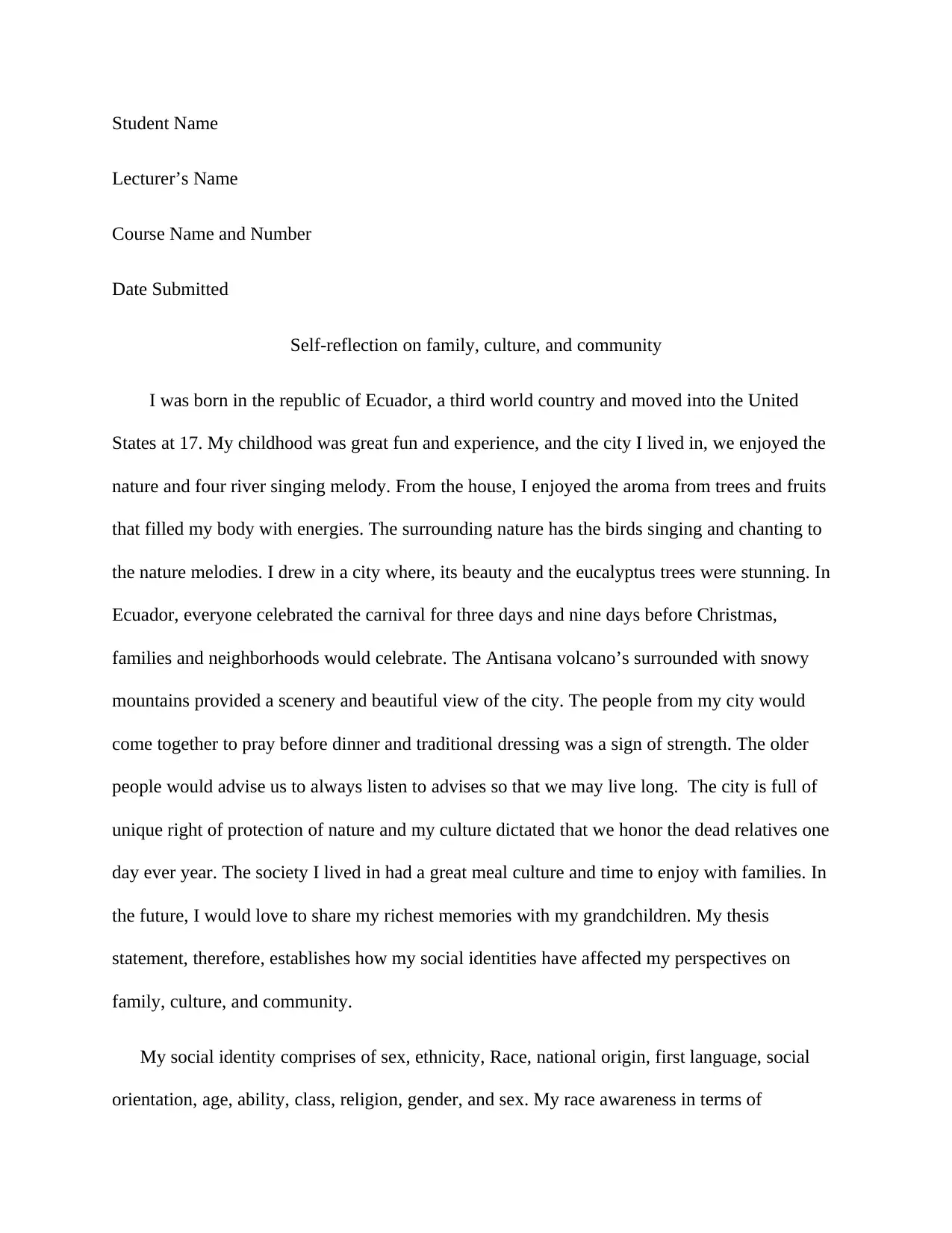
Student Name
Lecturer’s Name
Course Name and Number
Date Submitted
Self-reflection on family, culture, and community
I was born in the republic of Ecuador, a third world country and moved into the United
States at 17. My childhood was great fun and experience, and the city I lived in, we enjoyed the
nature and four river singing melody. From the house, I enjoyed the aroma from trees and fruits
that filled my body with energies. The surrounding nature has the birds singing and chanting to
the nature melodies. I drew in a city where, its beauty and the eucalyptus trees were stunning. In
Ecuador, everyone celebrated the carnival for three days and nine days before Christmas,
families and neighborhoods would celebrate. The Antisana volcano’s surrounded with snowy
mountains provided a scenery and beautiful view of the city. The people from my city would
come together to pray before dinner and traditional dressing was a sign of strength. The older
people would advise us to always listen to advises so that we may live long. The city is full of
unique right of protection of nature and my culture dictated that we honor the dead relatives one
day ever year. The society I lived in had a great meal culture and time to enjoy with families. In
the future, I would love to share my richest memories with my grandchildren. My thesis
statement, therefore, establishes how my social identities have affected my perspectives on
family, culture, and community.
My social identity comprises of sex, ethnicity, Race, national origin, first language, social
orientation, age, ability, class, religion, gender, and sex. My race awareness in terms of
Lecturer’s Name
Course Name and Number
Date Submitted
Self-reflection on family, culture, and community
I was born in the republic of Ecuador, a third world country and moved into the United
States at 17. My childhood was great fun and experience, and the city I lived in, we enjoyed the
nature and four river singing melody. From the house, I enjoyed the aroma from trees and fruits
that filled my body with energies. The surrounding nature has the birds singing and chanting to
the nature melodies. I drew in a city where, its beauty and the eucalyptus trees were stunning. In
Ecuador, everyone celebrated the carnival for three days and nine days before Christmas,
families and neighborhoods would celebrate. The Antisana volcano’s surrounded with snowy
mountains provided a scenery and beautiful view of the city. The people from my city would
come together to pray before dinner and traditional dressing was a sign of strength. The older
people would advise us to always listen to advises so that we may live long. The city is full of
unique right of protection of nature and my culture dictated that we honor the dead relatives one
day ever year. The society I lived in had a great meal culture and time to enjoy with families. In
the future, I would love to share my richest memories with my grandchildren. My thesis
statement, therefore, establishes how my social identities have affected my perspectives on
family, culture, and community.
My social identity comprises of sex, ethnicity, Race, national origin, first language, social
orientation, age, ability, class, religion, gender, and sex. My race awareness in terms of
Paraphrase This Document
Need a fresh take? Get an instant paraphrase of this document with our AI Paraphraser
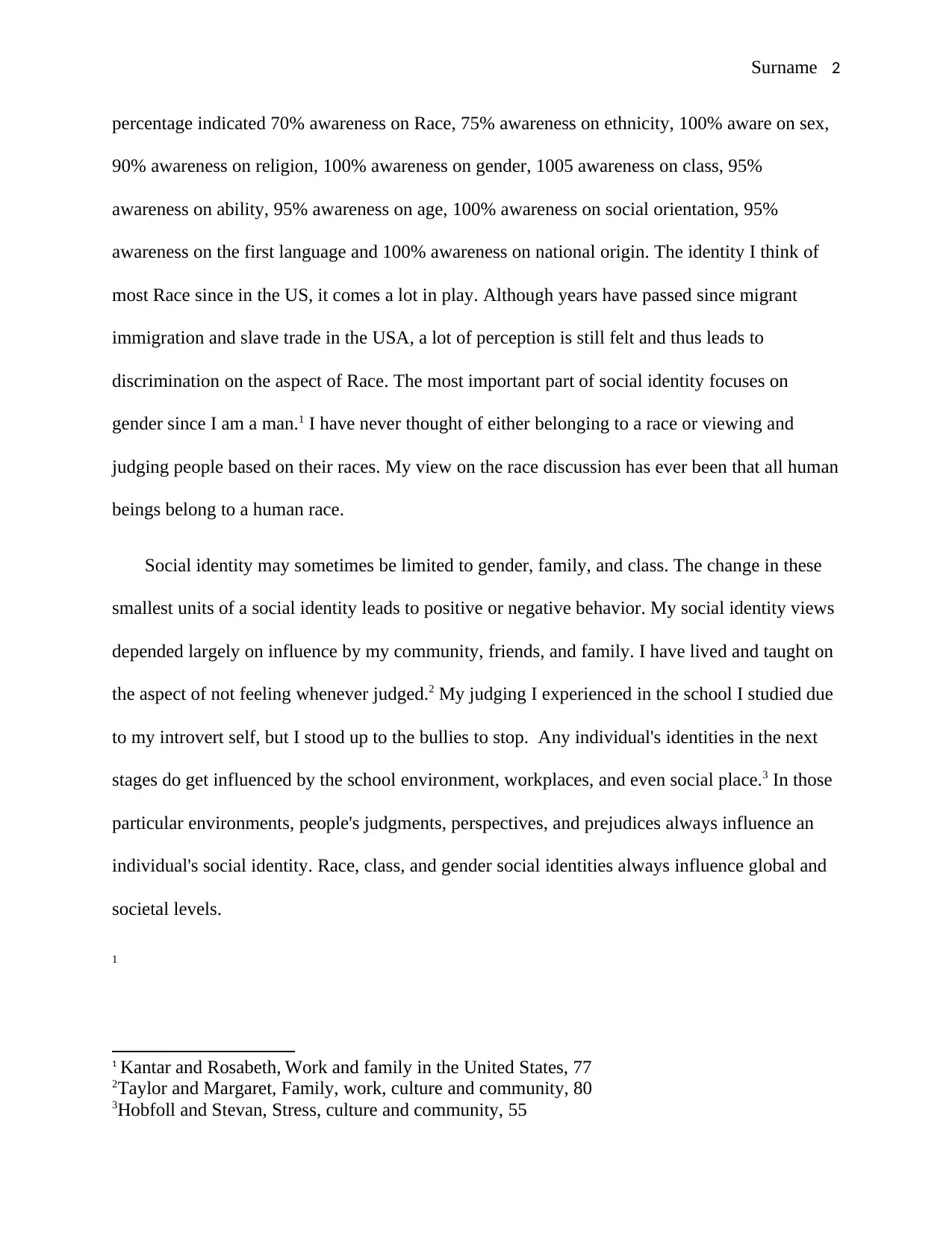
Surname 2
percentage indicated 70% awareness on Race, 75% awareness on ethnicity, 100% aware on sex,
90% awareness on religion, 100% awareness on gender, 1005 awareness on class, 95%
awareness on ability, 95% awareness on age, 100% awareness on social orientation, 95%
awareness on the first language and 100% awareness on national origin. The identity I think of
most Race since in the US, it comes a lot in play. Although years have passed since migrant
immigration and slave trade in the USA, a lot of perception is still felt and thus leads to
discrimination on the aspect of Race. The most important part of social identity focuses on
gender since I am a man.1 I have never thought of either belonging to a race or viewing and
judging people based on their races. My view on the race discussion has ever been that all human
beings belong to a human race.
Social identity may sometimes be limited to gender, family, and class. The change in these
smallest units of a social identity leads to positive or negative behavior. My social identity views
depended largely on influence by my community, friends, and family. I have lived and taught on
the aspect of not feeling whenever judged.2 My judging I experienced in the school I studied due
to my introvert self, but I stood up to the bullies to stop. Any individual's identities in the next
stages do get influenced by the school environment, workplaces, and even social place.3 In those
particular environments, people's judgments, perspectives, and prejudices always influence an
individual's social identity. Race, class, and gender social identities always influence global and
societal levels.
1
1 Kantar and Rosabeth, Work and family in the United States, 77
2Taylor and Margaret, Family, work, culture and community, 80
3Hobfoll and Stevan, Stress, culture and community, 55
percentage indicated 70% awareness on Race, 75% awareness on ethnicity, 100% aware on sex,
90% awareness on religion, 100% awareness on gender, 1005 awareness on class, 95%
awareness on ability, 95% awareness on age, 100% awareness on social orientation, 95%
awareness on the first language and 100% awareness on national origin. The identity I think of
most Race since in the US, it comes a lot in play. Although years have passed since migrant
immigration and slave trade in the USA, a lot of perception is still felt and thus leads to
discrimination on the aspect of Race. The most important part of social identity focuses on
gender since I am a man.1 I have never thought of either belonging to a race or viewing and
judging people based on their races. My view on the race discussion has ever been that all human
beings belong to a human race.
Social identity may sometimes be limited to gender, family, and class. The change in these
smallest units of a social identity leads to positive or negative behavior. My social identity views
depended largely on influence by my community, friends, and family. I have lived and taught on
the aspect of not feeling whenever judged.2 My judging I experienced in the school I studied due
to my introvert self, but I stood up to the bullies to stop. Any individual's identities in the next
stages do get influenced by the school environment, workplaces, and even social place.3 In those
particular environments, people's judgments, perspectives, and prejudices always influence an
individual's social identity. Race, class, and gender social identities always influence global and
societal levels.
1
1 Kantar and Rosabeth, Work and family in the United States, 77
2Taylor and Margaret, Family, work, culture and community, 80
3Hobfoll and Stevan, Stress, culture and community, 55
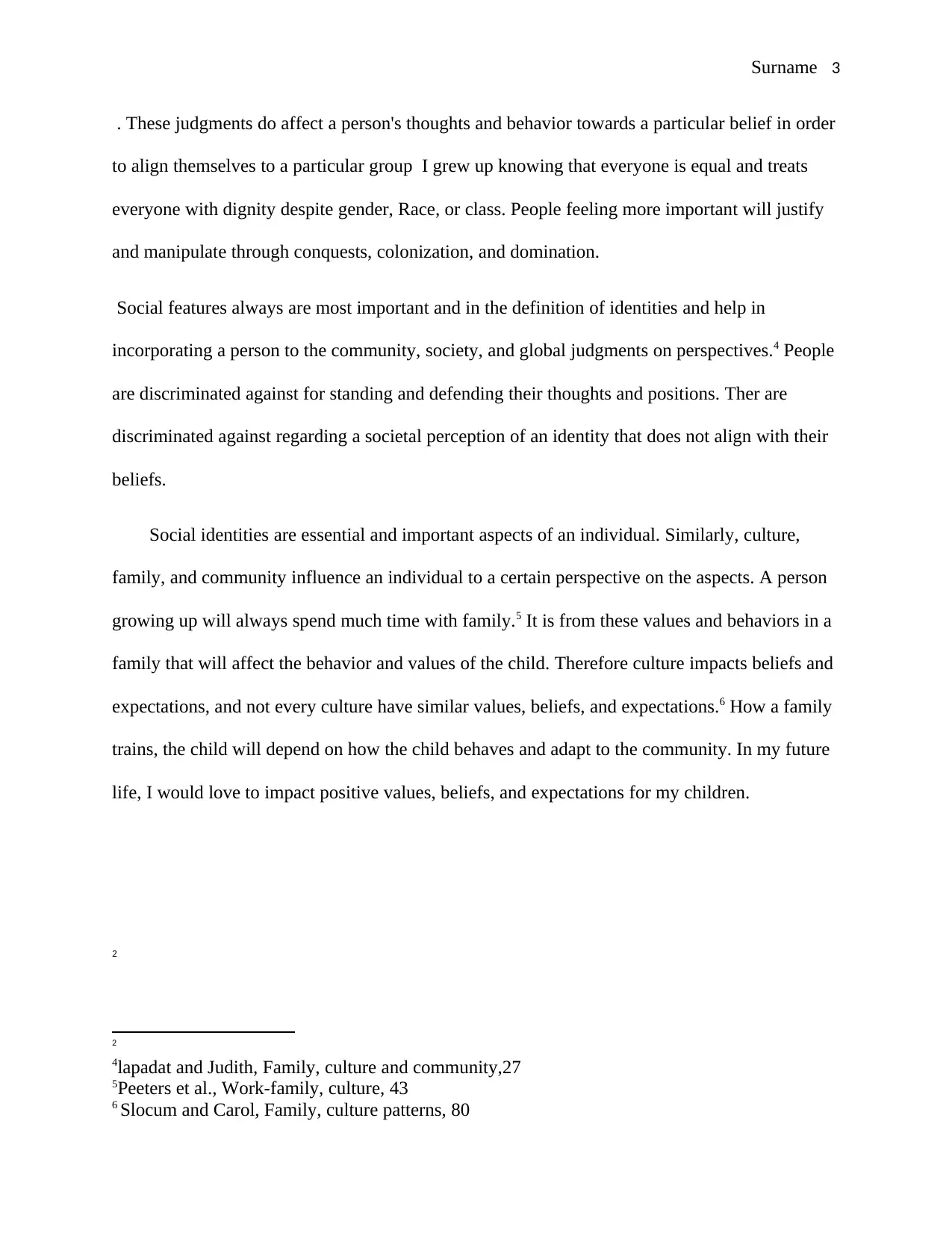
Surname 3
. These judgments do affect a person's thoughts and behavior towards a particular belief in order
to align themselves to a particular group I grew up knowing that everyone is equal and treats
everyone with dignity despite gender, Race, or class. People feeling more important will justify
and manipulate through conquests, colonization, and domination.
Social features always are most important and in the definition of identities and help in
incorporating a person to the community, society, and global judgments on perspectives.4 People
are discriminated against for standing and defending their thoughts and positions. Ther are
discriminated against regarding a societal perception of an identity that does not align with their
beliefs.
Social identities are essential and important aspects of an individual. Similarly, culture,
family, and community influence an individual to a certain perspective on the aspects. A person
growing up will always spend much time with family.5 It is from these values and behaviors in a
family that will affect the behavior and values of the child. Therefore culture impacts beliefs and
expectations, and not every culture have similar values, beliefs, and expectations.6 How a family
trains, the child will depend on how the child behaves and adapt to the community. In my future
life, I would love to impact positive values, beliefs, and expectations for my children.
2
2
4lapadat and Judith, Family, culture and community,27
5Peeters et al., Work-family, culture, 43
6 Slocum and Carol, Family, culture patterns, 80
. These judgments do affect a person's thoughts and behavior towards a particular belief in order
to align themselves to a particular group I grew up knowing that everyone is equal and treats
everyone with dignity despite gender, Race, or class. People feeling more important will justify
and manipulate through conquests, colonization, and domination.
Social features always are most important and in the definition of identities and help in
incorporating a person to the community, society, and global judgments on perspectives.4 People
are discriminated against for standing and defending their thoughts and positions. Ther are
discriminated against regarding a societal perception of an identity that does not align with their
beliefs.
Social identities are essential and important aspects of an individual. Similarly, culture,
family, and community influence an individual to a certain perspective on the aspects. A person
growing up will always spend much time with family.5 It is from these values and behaviors in a
family that will affect the behavior and values of the child. Therefore culture impacts beliefs and
expectations, and not every culture have similar values, beliefs, and expectations.6 How a family
trains, the child will depend on how the child behaves and adapt to the community. In my future
life, I would love to impact positive values, beliefs, and expectations for my children.
2
2
4lapadat and Judith, Family, culture and community,27
5Peeters et al., Work-family, culture, 43
6 Slocum and Carol, Family, culture patterns, 80
⊘ This is a preview!⊘
Do you want full access?
Subscribe today to unlock all pages.

Trusted by 1+ million students worldwide
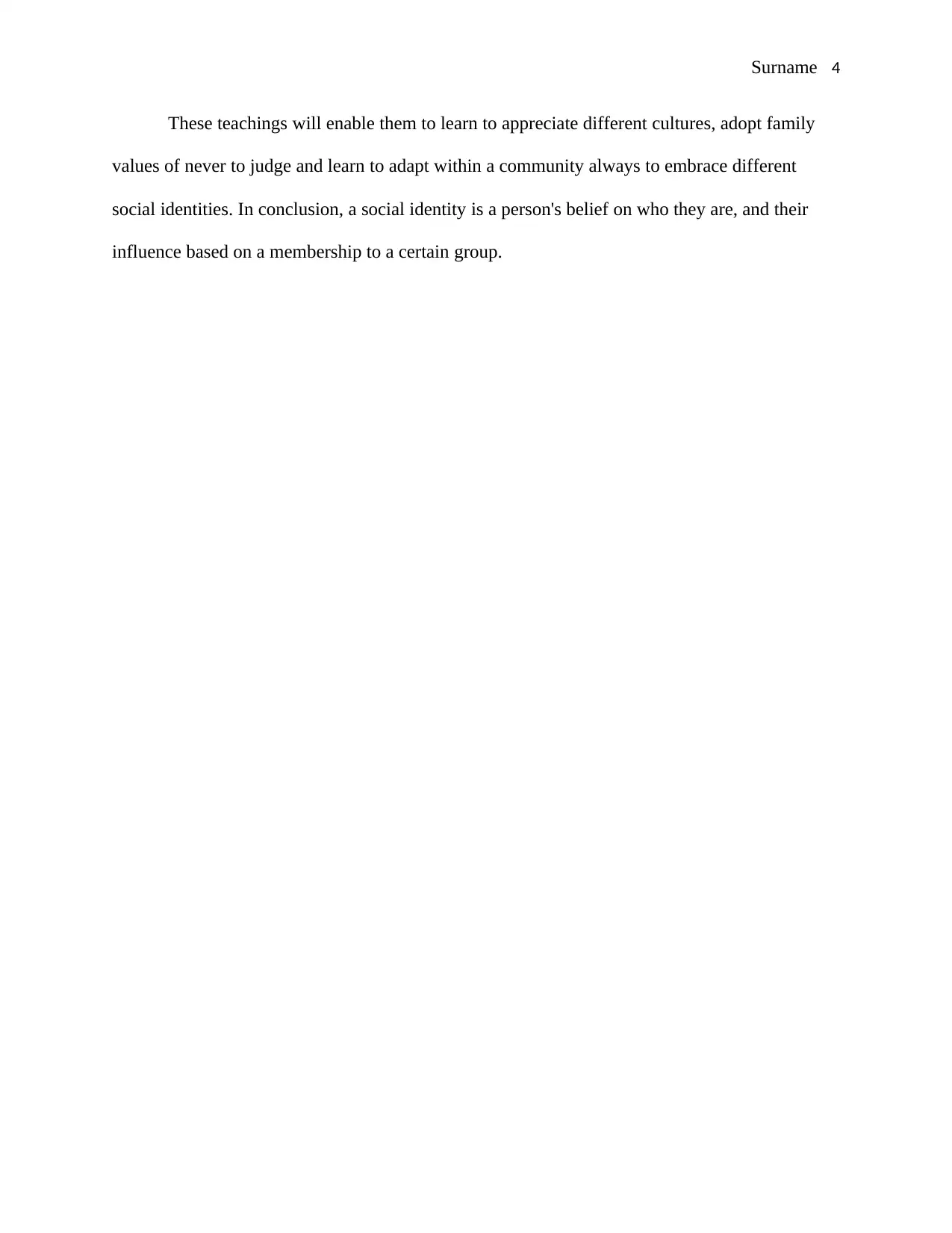
Surname 4
These teachings will enable them to learn to appreciate different cultures, adopt family
values of never to judge and learn to adapt within a community always to embrace different
social identities. In conclusion, a social identity is a person's belief on who they are, and their
influence based on a membership to a certain group.
These teachings will enable them to learn to appreciate different cultures, adopt family
values of never to judge and learn to adapt within a community always to embrace different
social identities. In conclusion, a social identity is a person's belief on who they are, and their
influence based on a membership to a certain group.
Paraphrase This Document
Need a fresh take? Get an instant paraphrase of this document with our AI Paraphraser
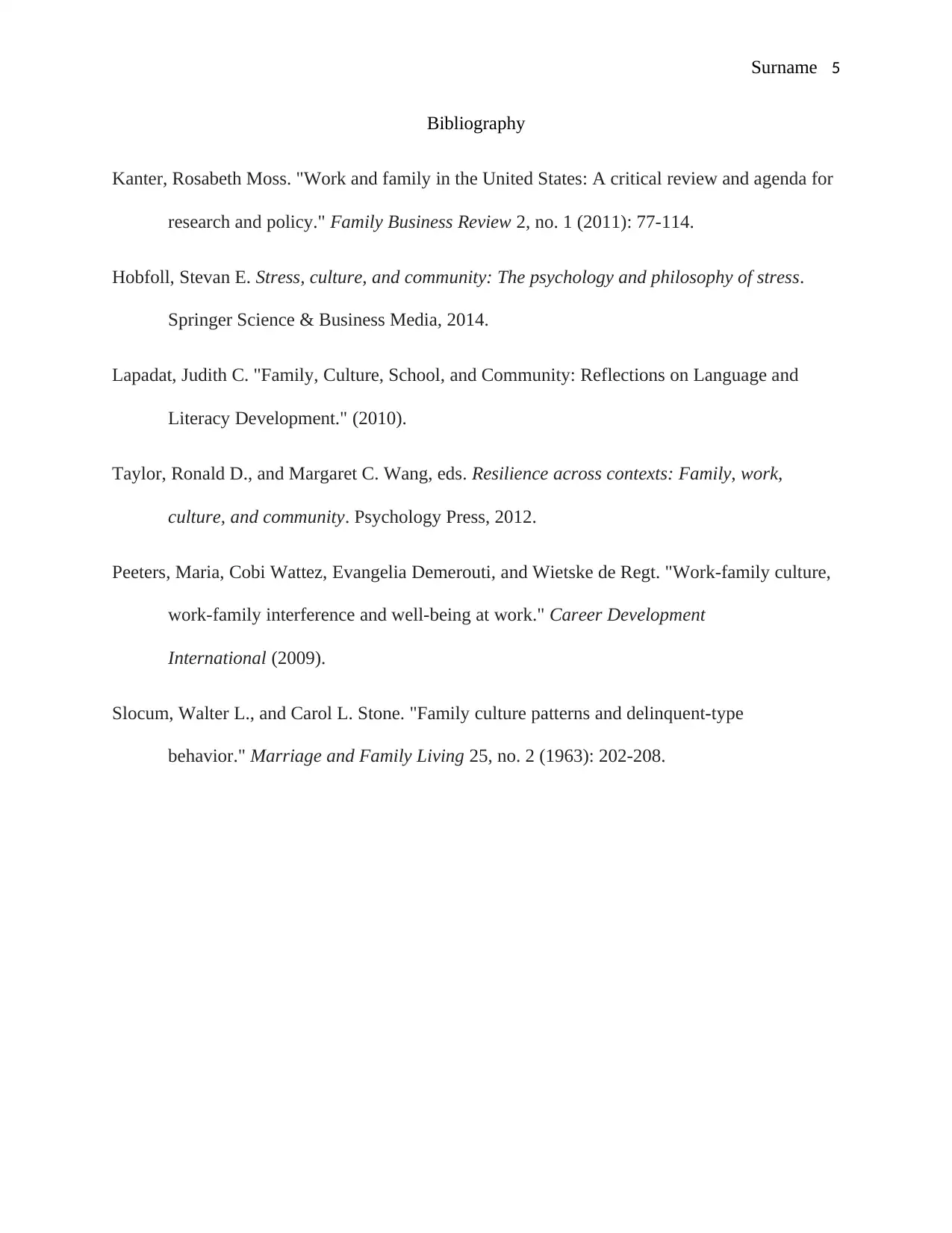
Surname 5
Bibliography
Kanter, Rosabeth Moss. "Work and family in the United States: A critical review and agenda for
research and policy." Family Business Review 2, no. 1 (2011): 77-114.
Hobfoll, Stevan E. Stress, culture, and community: The psychology and philosophy of stress.
Springer Science & Business Media, 2014.
Lapadat, Judith C. "Family, Culture, School, and Community: Reflections on Language and
Literacy Development." (2010).
Taylor, Ronald D., and Margaret C. Wang, eds. Resilience across contexts: Family, work,
culture, and community. Psychology Press, 2012.
Peeters, Maria, Cobi Wattez, Evangelia Demerouti, and Wietske de Regt. "Work‐family culture,
work‐family interference and well‐being at work." Career Development
International (2009).
Slocum, Walter L., and Carol L. Stone. "Family culture patterns and delinquent-type
behavior." Marriage and Family Living 25, no. 2 (1963): 202-208.
Bibliography
Kanter, Rosabeth Moss. "Work and family in the United States: A critical review and agenda for
research and policy." Family Business Review 2, no. 1 (2011): 77-114.
Hobfoll, Stevan E. Stress, culture, and community: The psychology and philosophy of stress.
Springer Science & Business Media, 2014.
Lapadat, Judith C. "Family, Culture, School, and Community: Reflections on Language and
Literacy Development." (2010).
Taylor, Ronald D., and Margaret C. Wang, eds. Resilience across contexts: Family, work,
culture, and community. Psychology Press, 2012.
Peeters, Maria, Cobi Wattez, Evangelia Demerouti, and Wietske de Regt. "Work‐family culture,
work‐family interference and well‐being at work." Career Development
International (2009).
Slocum, Walter L., and Carol L. Stone. "Family culture patterns and delinquent-type
behavior." Marriage and Family Living 25, no. 2 (1963): 202-208.
1 out of 5
Related Documents
Your All-in-One AI-Powered Toolkit for Academic Success.
+13062052269
info@desklib.com
Available 24*7 on WhatsApp / Email
![[object Object]](/_next/static/media/star-bottom.7253800d.svg)
Unlock your academic potential
Copyright © 2020–2025 A2Z Services. All Rights Reserved. Developed and managed by ZUCOL.





